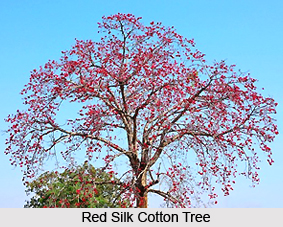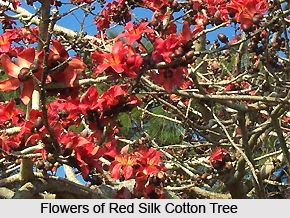 As the name goes, the Red Silk Cotton is in fact a reddish and silky tree. The scientists know this as Bombax Malabarica. Bombax came from the Greek word Bombax that means "a silk-worm" and Malabarica means "from Malabar". It derived from the family of Malvaceae. Like the other flowers this also has a lot of names in different parts of India. In Hindi it has as many names as Simal, Shimbal, Pagun, Semur, Kantisembal or Ragatsemal. In Bengali it is known as Ragtasimal, Simul and Tula. The Tamil people call it as either Avu or Kaddu-Olaga or Kaddu-Parati. While in Malayalam it is Llavu and in Telugu it is Buraga, it is called as Katumbu in Sinhalese.
As the name goes, the Red Silk Cotton is in fact a reddish and silky tree. The scientists know this as Bombax Malabarica. Bombax came from the Greek word Bombax that means "a silk-worm" and Malabarica means "from Malabar". It derived from the family of Malvaceae. Like the other flowers this also has a lot of names in different parts of India. In Hindi it has as many names as Simal, Shimbal, Pagun, Semur, Kantisembal or Ragatsemal. In Bengali it is known as Ragtasimal, Simul and Tula. The Tamil people call it as either Avu or Kaddu-Olaga or Kaddu-Parati. While in Malayalam it is Llavu and in Telugu it is Buraga, it is called as Katumbu in Sinhalese.
The Red Silk Cotton is tall and handsome tree. You can find it in almost every part of India, Sri Lanka, Burma and Malaysia only except those areas where the climate is dry and arid. But it is most commonly found in the Konkan. In a whorled formation around the main stem, the horizontal branches of the tree usually arrange in twos and threes. In order to support the top, the straight and ashy shaft often strengthens. The trunk does also get clothed with solid, pointed prickles. This probably the natural way of the tree to protect itself from the looting monkeys at bay. Later in the year or approaching to March, the leaves of the tree shrink and fall making the tree very thin and bare. But in the month of January or February, little enlargements appear on the twigs and very rapidly they develop into strong and heavy buds. They become pinkish-purple in colour at this time.
 No trees can be compared to the extent of Red Cotton in attracting the birds. A large number of birds like Bulbuls, Mynahs, Sunbirds, Flower-peckers, Crows and Rosy Pastors constantly chat there in every tree in bloom. Some other birds quarrel and push each other to swallow the delicious nectar. With all these activities, many flowers are fertilized very well. The very well-known fruits can be seen in April. They look like big, green fingers pointed to all directions at first. But later on, they become brown and fragile. With stuffed, feathery cotton, they drop down to their base. At this point of time, the tree takes a very odd sight. It looks like wrapped up with cotton wool and around the base, there lie some fragment of floss scatterd. This is very short, soft and slippery and named as Indian Kapok. This is vividly used to make pillows and cushions.
No trees can be compared to the extent of Red Cotton in attracting the birds. A large number of birds like Bulbuls, Mynahs, Sunbirds, Flower-peckers, Crows and Rosy Pastors constantly chat there in every tree in bloom. Some other birds quarrel and push each other to swallow the delicious nectar. With all these activities, many flowers are fertilized very well. The very well-known fruits can be seen in April. They look like big, green fingers pointed to all directions at first. But later on, they become brown and fragile. With stuffed, feathery cotton, they drop down to their base. At this point of time, the tree takes a very odd sight. It looks like wrapped up with cotton wool and around the base, there lie some fragment of floss scatterd. This is very short, soft and slippery and named as Indian Kapok. This is vividly used to make pillows and cushions.
Apart from that, the Red Silk Cotton has some other very valuable usage as well. The brown coloured, astringent gum that people obtain from the Silk Cotton, use as a tonic. This gum is known as `Mocharas`. This gum is also used as a substitute for "gum tragacanth" being called as `Katira`. This is also used for the purposes like bookbinding, cosmetics, thickening the ice cream and sometimes even as a medicine. The tree has some other medicinal and economic usage as well.
From the Monsoon to the end of the year, the Silk Cotton remains well covered with fresh, green and spreading leaves. Each of the three to seven leaflets is about 15 cm in length. At this time, people can easily recognize the tree with the horizontal prickly branches and the unusual shape of the leaves. Simul is a whitish, soft and light kind of wood. Though it`s not that durable, it is used for making packing cases, coffins and matches. Since it is more durable under water, it is also used for dugout canoes, weil-linings and floats. There is another cotton that belongs to the same family and known as Sated Simal or White Silk Cotton is very similar in leaf and general growth with the Red Silk Cotton. But the flowers that appear in February are smaller and dirty white in colour and also hang in clusters. The Yellow Silk Cotton or Torchwood Tree and Kumbi in the vernacular, belongs to the Bixacece family and is totally distinct from the true Silk Cotton. One can find it mostly in dry, hilly districts that are thriving in the hottest and stoniest places.



















